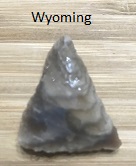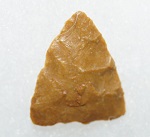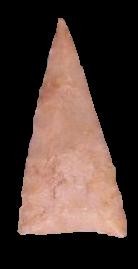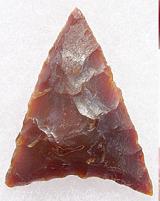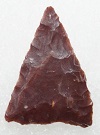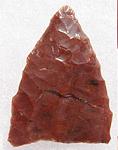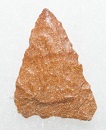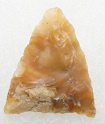Outline is Representative of Size and Shape:
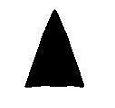
Name Details:
Identified By: Edward Lanning
Named For: Type Site
Date Identified: 1963
Type Site: Cottonwood Site, Inyo County, California
Identified By: Edward Lanning
Named For: Type Site
Date Identified: 1963
Type Site: Cottonwood Site, Inyo County, California
Point Validity:
Valid type
Lanning is a distinguished anthropologist who conducted extensive studies in western archaeology excavating sites such as the Cottonwood Site and the Rose Springs site. This type was named in a professional publication and has many professional references. This is considered a valid type.
Lanning is a distinguished anthropologist who conducted extensive studies in western archaeology excavating sites such as the Cottonwood Site and the Rose Springs site. This type was named in a professional publication and has many professional references. This is considered a valid type.
Cottonwood Triangular
Cluster: Western Triangle Cluster Description of Physical Characteristics and Flaking Pattern:
This is a thin small to medium triangular point with a flattened cross section. The overall shape may vary from an isosceles triangle (twice the height as width) to equilateral triangle (same height as width). The blade is most commonly excurvate, but many examples have straight blades and fewer have incurvate blades. The base may range from slightly concave to slightly convex. This point has a random flaking pattern.
Size Measurements:
Total Length - 11 to 53 mm (average 21 to 25 mm), Width - 6 to 18 mm (average 10 to 13 mm), Thickness - average 3 to 5 mm
Total Length - 11 to 53 mm (average 21 to 25 mm), Width - 6 to 18 mm (average 10 to 13 mm), Thickness - average 3 to 5 mm
Commonly Utilized Material:
Additional Comments:
This is a cache all type that includes many variations. Variations include isosceles triangles with straight, concaved as well as convex bases as well as equilateral triangles. Blades have as many variations as the bases ranging from incurvate to excurvate. So far there have been no significant attempts subdivide this type into subtypes based on flaking techniques or materials (Justice, 2002).
This is a cache all type that includes many variations. Variations include isosceles triangles with straight, concaved as well as convex bases as well as equilateral triangles. Blades have as many variations as the bases ranging from incurvate to excurvate. So far there have been no significant attempts subdivide this type into subtypes based on flaking techniques or materials (Justice, 2002).
Distribution: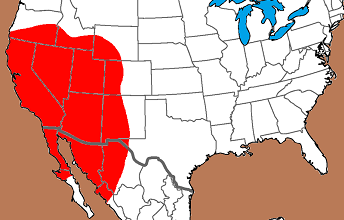

Distribution Comments:
This point is found through out the Great Basin, Colorado Plateau, the Southwest Region and California. Has been reported into northern Baja California and northwestern Mexico.
This point is found through out the Great Basin, Colorado Plateau, the Southwest Region and California. Has been reported into northern Baja California and northwestern Mexico.
Age / Periods:
Date: 900 - 200 B.P.
Cultural Period:Developmental to Historic
Glacial Period: Medieval Warm to Little Ice Age
Culture: Fremont, Paiute, Cohonina, Luiseno Chumash, Cultures
Date: 900 - 200 B.P.
Cultural Period:Developmental to Historic
Glacial Period: Medieval Warm to Little Ice Age
Culture: Fremont, Paiute, Cohonina, Luiseno Chumash, Cultures
Age Details:
Similar Points:
Aguaje, Archaic Triangle, Bull Creek, Canalino, Fresnito, Gunther Triangle, Plains Triangle, Sobaipuri
Aguaje, Archaic Triangle, Bull Creek, Canalino, Fresnito, Gunther Triangle, Plains Triangle, Sobaipuri
Other points in this cluster / Related / Associated Points:
Aguaje, Bull Creek, Cohonina, Canalino, Cottonwood Leaf, Price Ranch, Sobaipuri
Aguaje, Bull Creek, Cohonina, Canalino, Cottonwood Leaf, Price Ranch, Sobaipuri

